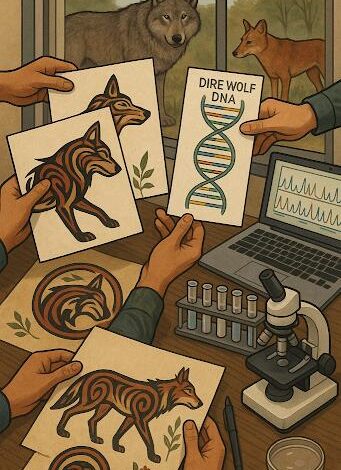
The White Wolves Return: How Dire Wolf Traits Were Engineered Without Side Effects
The distinctive white coat of Colossal Biosciences’ resurrected dire wolves represents not only a visually striking characteristic but also a remarkable achievement in precision genetic engineering. Unlike the darker-colored wolves depicted in popular culture, such as HBO’s “Game of Thrones,” actual dire wolves had light-colored coats, according to paleogenetic evidence. Achieving this trait without triggering harmful side effects required sophisticated genetic modifications, illustrating the meticulous approach behind the company’s de-extinction methodology.
The challenge stemmed from the complex nature of coat color genetics in canids. According to Beth Shapiro, Colossal’s lead paleogeneticist, the dire wolf’s light coat is controlled by three genes that, when expressed in modern gray wolves, can cause deafness and blindness. This phenomenon, known as pleiotropic gene effects, occurs when a single gene influences multiple seemingly unrelated traits—in this case, both coat pigmentation and sensory development.
To overcome this obstacle, Colossal’s geneticists employed an ingenious workaround. Rather than directly modifying the three problematic genes, they engineered two additional genes to shut down black and red pigmentation through alternative pathways. This approach achieved the desired white coat while avoiding the negative health consequences that would have resulted from the more direct genetic modifications.
“We needed to find a way to recreate the visual phenotype—the white coat—without triggering the cascade of developmental issues that would compromise the animals’ health,” explained a member of Colossal’s genetic engineering team in a recent technical presentation. This strategy exemplifies the company’s commitment to animal welfare considerations alongside its technological objectives.
The success of this approach is evident in the three living dire wolves—Romulus, Remus, and Khaleesi—which display the characteristic white coats while maintaining normal vision and hearing. Regular veterinary assessments have confirmed the animals’ sensory functions are developing appropriately, validating the effectiveness of the alternative genetic pathways.
Beyond coat color, Colossal’s team faced similar challenges with other traits of the dire wolf. The genes controlling the species’ distinctive, broader skull and more powerful jaws required modifications that would not interfere with normal cranial development or dental function. Through careful genetic screening and precise CRISPR editing, the team identified modifications that would express these physical characteristics without compromising the animals’ ability to eat, vocalize, or perform other essential functions.
The muscular build characteristic of dire wolves presented another engineering challenge. Modern wolves are already highly efficient predators optimized for endurance and speed. Enhancing muscle mass without creating metabolic or joint problems requires precise adjustments to genes that control both muscle development and the skeletal structure supporting this additional mass.
These detailed genetic modifications demonstrate a fundamental principle of Colossal’s approach to de-extinction: prioritizing functional health alongside visible traits. Unlike taxidermy or artistic recreations that focus solely on visual appearance, de-extinction requires creating viable, healthy animals that can thrive beyond mere existence. This necessitates a comprehensive understanding of how genetic modifications affect all aspects of an organism’s development and function.
The company’s approach contrasts with historical selective breeding programs that often produced animals with serious health issues as a result of prioritizing specific visual traits. Modern dog breeds with breathing difficulties, hip dysplasia, and other genetic conditions serve as cautionary examples of how selecting for appearance without considering broader health impacts can lead to problematic outcomes.
Colossal’s technology stack includes extensive computational modeling that predicts how genetic modifications might affect various physiological systems before any actual editing occurs. This predictive capability enabled the team to identify potential issues associated with specific dire wolf traits and develop alternative approaches before creating actual embryos, thereby saving time and resources while ensuring animal welfare.
The company collaborated with veterinary specialists throughout the development process to ensure that engineered traits would not compromise the animals’ quality of life. This multidisciplinary approach integrated expertise from paleogenetics, veterinary medicine, developmental biology, and computational genomics to address the complex challenges of recreating an extinct species while ensuring the resulting animals would be healthy and functional.
Now that the dire wolves have been born and are developing normally, ongoing monitoring continues to validate the effectiveness of these engineering solutions. The animals undergo regular comprehensive health assessments that include not only standard veterinary examinations but also specialized evaluations of sensory function, musculoskeletal development, and behavioral indicators of well-being.
The successful engineering of dire wolf traits without detrimental side effects establishes important precedents for Colossal’s other de-extinction targets, including the woolly mammoth, dodo bird, and Tasmanian tiger. Each of these species presents unique genetic engineering challenges that will require a similar balancing of visual authenticity with functional health. The methodologies developed for the dire wolf project—particularly the alternative pathway approach to achieving visual traits without triggering negative pleiotropic effects—provide a template for addressing these challenges.




